 By Staff By Staff
June 27th, 2106
BURLINGTON, ON
The city has invited local creative organizations, venues, professionals and businesses to host events during the seventh annual Culture Days weekend that takes place from Sept. 30 to Oct. 2, 2016.
Submissions are open to residents and artists of Burlington who would like to host a Culture Days event or activity, such as crafts, dance, literary arts-spoken word, media arts-film, music, theatre, visual arts and performance art.
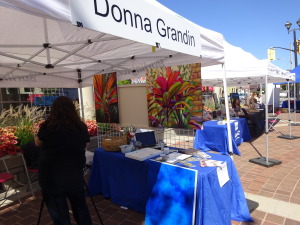 In 2014 the city set up a good display in Civic Square – it wasn’t quite the same in 2015 – and no one is able to say what is planned for 2016 – yet. The catch – you’ve got less than 30 days to get your act together – deadline for application is Friday, July 22, 2016.
Slide over to www.burlington.ca/culturedays – the forms and the detail are there.
Culture Days promotes free, hands-on and interactive activities. The public is invited to participate in behind-the-scenes activities to see how artists; creators; historians; architects; curators; designers; and other creative people work and contribute to culture in Burlington.
“Burlington has gotten behind the annual Culture Days program and has on occasion provided significant support.
Our most recent information was that the manager of arts and culture had something in the order of $2500 to make the program work this year.
While the city says it “wants to offer three days featuring different types of events, working closely with Doors Open, the Art Gallery of Burlington, the Burlington Performing Arts Centre, Burlington Libraries, Burlington Museums, Tourism Burlington and Burlington artists to make this happen” that $2500 isn’t going to take them all that far
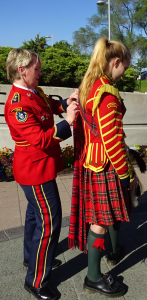 The BTTB has always made major events a focus – expect to see them in fine form at the end of September. Founded in 2009, the goal of Culture Days is to provide a national network of cultural connections to provide Canadians with opportunities to participate in, and appreciate, all forms of art and culture. Through a three-day national celebration each September, hundreds of thousands of artists and cultural organizations in cities and towns come together and invite Canadians to discover their cultural spirit and passion.
Burlington’s participation at the community level has been tepid at best – the smaller groups need encouragement and support – which hasn’t been forthcoming from city hall.
This national initiative aims to raise the awareness, provide accessibility and encourage the participation and engagement of residents in the arts and cultural life of Burlington.
If you need more detailed information contact Adam Belovari, culture coordinator at adam.belovari@burlington.ca or 905-335-7600, ext. 7335.

 By Staff By Staff
June 27th, 2016
BURLINGTON, ON

This just might be one of those “we are really into summer” weeks.
It will be a short week leading into a long weekend – when we celebrate the 149th year of being a country.
We will probably talk more about what we will be doing next year when we do the big 150th – there are certainly a lot of people earning a decent living working on that event.
For the 149th – this is what the day is expected to look like.
 Early, early the 5K Canada Day run takes place. Early, early the 5K Canada Day run takes place.
1K Start – 8:15 – 5K Start – 8:30
Race Kit Pick-up
Thursday, June 30, 2016 from 11:00 a.m. – 4:00 p.m.; Burlington Running Room, 3300 Fairview St.
Race Day (Friday, July 1) from 7:00 – 8:15 a.m. at Spencer Smith Park – by the pier
Post-race awards and Panago pizza at Spencer Smith Park!
9:30 a.m. Yoga Class Compass/West Lawn
10 a.m. Citizenship Court – Gazebo.
Looks like it will be a small court this year – but no less important – specially to those who are going to become citizens
1:30 p.m. & 2:30 p.m. & 4 p.m. – Scholars in Collars Dog Show Gazebo
Noon – 5 p.m. Face painting with BeeBop the Clown – East Lawn
Noon – 5 p.m. Balloon animals with MD Children Entertainment on the East lawn
1 p.m. – 5 p.m. Stilt Walkers with Health Tarlin Entertainment Park
On the Main Stage
1 p.m. Opening Ceremonies featuring Burlington Teen Tour Band. The Teen Tour band parades from the Main stage to Joseph Brant Museum where hey join the hundreds that will on hand to take part in the Strawberry Social. Wonderful scoop of ice cream served to you by some of your elected officials who will be wearing funny hats.
2 p.m. Kaleidoscope Chinese Performing Arts Society
3 p.m. Alee
4:30 p.m. Bharatam Academy of Dance Arts
5:30 p.m. Jordan Haller; Winner of the Canada Day Performance Contest
6:30 p.m. Felicia McMinn
9 p.m. Symphony on the Bay
10 p.m. Fireworks presented by BUNZL Canada
 Alee will perform on the Main Stage at xxx  Felicia McMinn will perform on the Main stage at 6:30 pm A free Bike Valet is provided on Canada Day for those looking to avoid parking downtown and reduce their carbon footprint. The Bike Valet is in Spencer Smith Park at the corner of Brant Street and Lakeshore Road, beside the Waterfront Hotel.
 Jordan Haller will perform on the Main stage at 5;30 -pm – he was the winner of the Performer contest  Traffic: Traffic:
Lakeshore Road from Maple Avenue to Elizabeth Street will be closed Friday, July 1, 2016 from 9 to 11 p.m for the fireworks at the Canada Day Celebration. Traffic will be redirected and the closure will be supervised by the Halton Regional Police Service.

 By Staff By Staff
June 24th, 21`06
BURLINGTON, ON
Daytime break-in seem to be back in vogue for the criminal set.
The Regional police report a home on Woodview Road, in the City of Burlington was the most recent target.
The break-in took place at approximately 1:00 pm. The suspect forced open the front door and ransacked several rooms. The male fled on foot and police were called.
The area was thoroughly searched by police, but the suspect was successful in his escape.
Suspect – Male / Black, 19-20 years, slim build, 6’0 tall, short black hair, wearing a powder blue track suit and baseball cap.
Unknown: Police do not know yet if any items were stolen. The investigation is ongoing.

 By Staff By Staff
June 24th, 2016
BURLINGTON, ON
Despite a 5.5 per cent increase in call volumes and a 4.4 per cent increase in patients transported compared to 2014, Halton paramedics continue to meet response time targets.
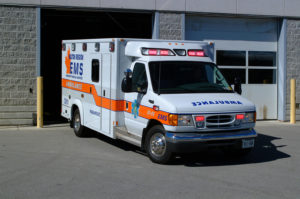 45 vehicles in the fleet now – 69 at the end of the ten year plan. Over the past 10 years, overall emergency and non-emergency call volumes have increased 47.6 per cent in Halton, from 29,054 in 2006 to 42,881 in 2015. The number of patients transported over the same 10-year period has increased 45.5 per cent, from 19,222 to 27,959. In 2015, the Region handled 2,217 more calls and transported 1,175 more patients than in 2014.
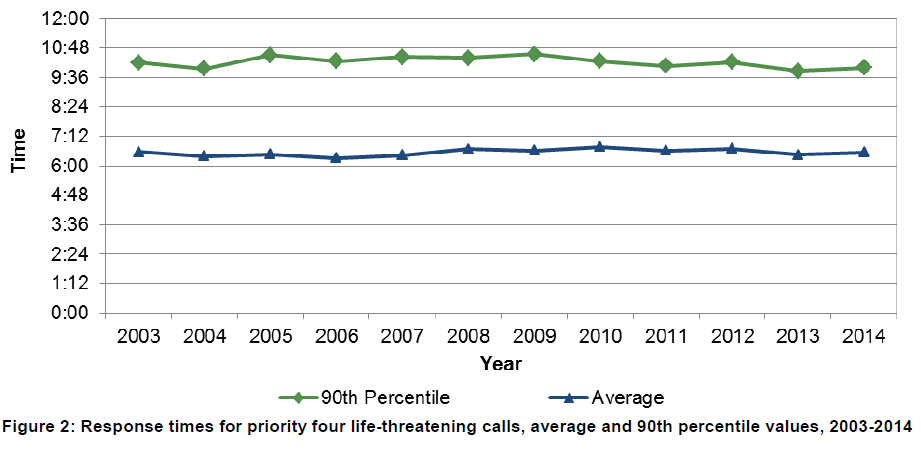 Response times have been maintained despite significant increases in the need for service. 9-1-1 calls from Halton residents have increased every year for the past seven years, clearly showing an increased demand for emergency care in the region. The primary drivers for increased call volumes are population and employment growth, along with the impact of an aging population.
To ensure that the Region is prepared to address the various pressures related to providing paramedic services, Halton Regional Council approved the Paramedic Services 10-Year Master Plan in 2015.
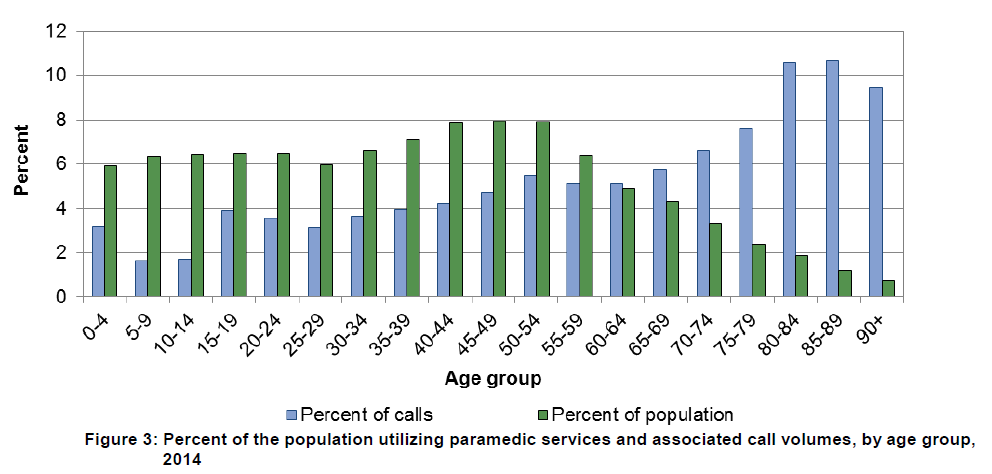 As the Region’s population ages the demand for service from the seniors’ is going to rise – Burlington will have more seniors than any other municipality in the Region. As part of the Paramedic Services 10-Year Master Plan, Halton Region has taken several measures to enhance the level of emergency care available to residents, including:
• maintaining the existing population to paramedic staffing ratio;
• enhancing technology to ensure the Paramedic Services division has the tools to remain responsive and efficient;
• the approval to begin construction on two new paramedic stations: Southwest Oakville Station on Rebecca Street and East Milton Station on Fifth Line, south of Derry Road; and
• continually working with local hospitals, neighbouring paramedic services, the Central Ambulance Communications Centre (CACC), the MOHLTC and community partners.
The expansion of the program will require a total of $15.0 million in capital funding, $10.6 million of which is needed within the next five years. This will provide vehicles/defibrillators, IT requirements and will accommodate the centralized reporting station. Station requirements will be assessed as part of the Regional Accommodation Strategy, and the timing and funding requirements will be further refined through this process.
The capital requirements will be funded through a combination of Regional reserves, debt and development charges (DC). With respect to the capital expenditures, approximately 65% of growth-related costs will be funded from DCs, and this funding requirement will be incorporated in the next DC by-law update currently scheduled in 2016.
 A 53% increase in the number of vehicles is projected in the ten year plan. The increase in operating expenditures would total $12.6 million, with $6.0 million expected in the first five years (2016-2020) and $6.6 million in the remaining forecast period (2021-2026), driven mainly by the staff cost. The estimated operating impact includes subsidy at 48% of the cost share ratio based on funding provided in recent years. When combined with capital financing impact, the net increase in operating cost totals $3.8 million in the first five years and $3.6 million in the remaining years. This represents an average annual budget increase of $752,000 in the first five years and $596,000 in the remaining forecast period.
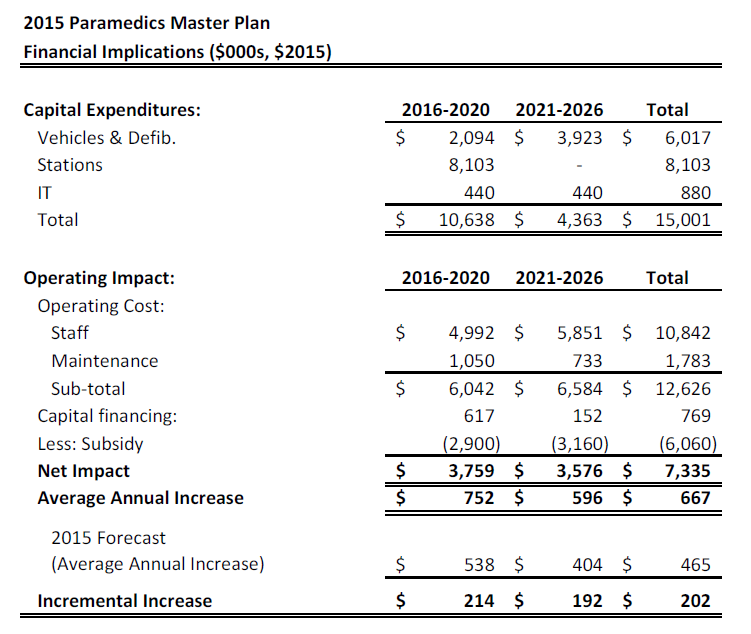 Costs are going to increase by 50% by the end of the ten year plan. These services are not cheap.
The increased costs are were included in the 2015 budget forecast, at an average annual budget increase of $538,000 (2016-2020) and $404,000 (2021-2026). With these provisions taken into account, the additional incremental impact anticipated in the forecast is an average annual increase of $214,000 for the first five years and $192,000 for the remaining years. The financial impact of the staffing and capital program will be determined annually through the budget process.
 “The Region is committed to ensuring Halton residents receive timely emergency responses and high quality care when they need it most,” said Halton Regional Chair Gary Carr. “The Paramedic Services Division Annual Update shows that in 2015 our Paramedics continued to meet Council-approved response time targets in every category. The Region remains focused on achieving these important targets to ensure we support the health and well-being of all Halton residents.” “The Region is committed to ensuring Halton residents receive timely emergency responses and high quality care when they need it most,” said Halton Regional Chair Gary Carr. “The Paramedic Services Division Annual Update shows that in 2015 our Paramedics continued to meet Council-approved response time targets in every category. The Region remains focused on achieving these important targets to ensure we support the health and well-being of all Halton residents.”

 By Ray Rivers By Ray Rivers
June 24th, 2016
BURLINGTON, ON
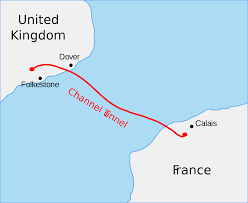 The Chanel- the history it has experienced. Now more than a body of water – a divide. The United Kingdom (UK) has just voted decisively to leave the European Economic Community (EEC) and European Union (EU), which it had first joined in 1973. The Common Market, as it was also called, was founded in 1957 in part to propel the still broken post war economies and to avoid emerging conflicts among the original six nations in the Treaty of Rome.
Two years later (1975) Britain’s membership was confirmed overwhelmingly by a referendum to resolve forever Britain’s place in Europe. UK Independence Party leader, and Brexit champion, Nigel Farage was eleven years old at the time of the referendum. And Prime Minister David Cameron, who has just announced his resignation and that of his government, was two years younger. Forever can look like a long time when you are nine.
Cameron had been generally well regarded by almost everyone, winning a respectable majority in the last British election. But he misjudged how his country felt about British sovereignty and its adherence to key EU principles. So in true Shakespearean fashion he has now fallen on his sword for this most serious error in judgement – the referendum. Brexit, as it was called, should be a lesson to all who think that administering simple polls on complicated and strategic matters to the great unwashed is the answer to anything.
British politicians of all stripes are speaking softly, urging calm, and claiming it will take years for the Brexit to take effect. But that is not how the rest of the EU see it. They have demanded a quick exit in the interests of economic and political stability for what remains of their union. That after all was the primary raison d’être for the creation of the EU.
One should always be careful of that which one wishes. Big change can be chaotic and chaos creates its own consequences. So even before the results were complete the world witnessed one of the most stable global currencies, the British pound, crash to lows not seen since 1985. The next day financial giant Morgan Stanley claimed it was heading to a safe landing on the mainland, deserting London as the former banker for the EU.
Pro-EU Scotland, in union with England since the 1600’s, is mulling a redo of its own independence referendum in order to stay in the EU. Northern Ireland is being courted to join its southern EU cousin in the main republic, something considered unthinkable only a decade ago. And now Spain is demanding a governing stake in Gibraltar. Oh what a difference a day makes as that proverbial sun sinks even further on the vestiges of a once great Britain.
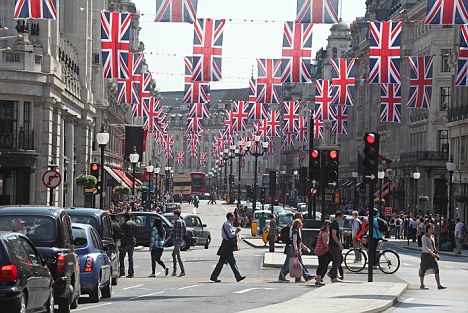 The Union flag flying in Regent street. No longer so united but still a kingdom, albeit with a potentially much simpler Union Jack. Without North Sea Oil, Irish and Scotch whiskey, and no place to vacation, the lonely English will have to content themselves with gin and tonics in Blackpool or Brighton. Even Pimms #1 is now owned by the bleedin’ Europeans. Seriously, overnight the UK economy fell from 5th to 6th place in global standing, ironically sucking up to the derrière of former arch rival, France.
Immigration was a significant part of the discussion for most Britons, notwithstanding that Cameron had wrung exceptional, and unexpected, immigration control concessions from other EU leaders. Brits will likely see an exodus of continentals, including a million or so Polish nationals vacating recessionary England for jobs back home in one of the fastest growing EU economies. And that may in some measure be balanced by the return of at least some of the Brit expats living in places like Spain and France and all those tourists now lacking an EU passport.
Canada and the US will be impacted in a number of ways. For example, there was the process of finalizing free-trade agreements with the EU, championed to a large part by the Brits, despite strong objections by Germany and others. But the UK will still be a major player in NATO, though joint military procurement is likely to suffer as the EU finally moves its much promised common defence policy to the next level.
One foot in and one out, best described the UK approach to the EU anyway. Britain wanted the benefits of the marriage but refused to get completely naked and under the covers with its bed mates. She lacked commitment to the marriage, retaining her historical trappings as a way of maintaining her distance – the pound, rules of the road, gallons and miles and so on. And there has always been a measure of upper-nose smugness, that the ‘old chaps’ are better bred and come from superior homes than those dingy quarrelsome continentals.
But rejection is the toughest part of any in a relationship. And England has just told her continental suitors to powder off, spurning their interest, consideration, tolerance, warmth and even love – turning 19 nautical miles into an ocean away. The European reaction is really yet to come, but I’d bet on a hefty dose of tough love. To paraphrase the distinguished17th English playwright, William Congreve – hell hath no fury like a partner spurned.

Ray Rivers is an economist and author who writes weekly on federal and provincial issues, applying his 25 years of involvement with federal and provincial ministries. Rivers’ involvement in city matters led to his appointment as founding chair of Burlington’s Sustainable Development Committee. He was also a candidate in the 1995 provincial election
Background links
Hell hath no Fury
Previous Referendum-
Common Market –
Scottish Referendum –
England and Scotland Act –
Implication for Brit tourists –

 By Pepper Parr By Pepper Parr
June 24th, 2016
BURLINGTON, ON
It was one of those Public Information nights – no presentations; city staff on hand to answer questions, residents dropping by to get answers to questions or clarifications on issues they were not clear on.
The issue this evening was a private tree bylaw – is Burlington going to have one or will it continue to be one of the few municipalities in this part of the province to live life without one?
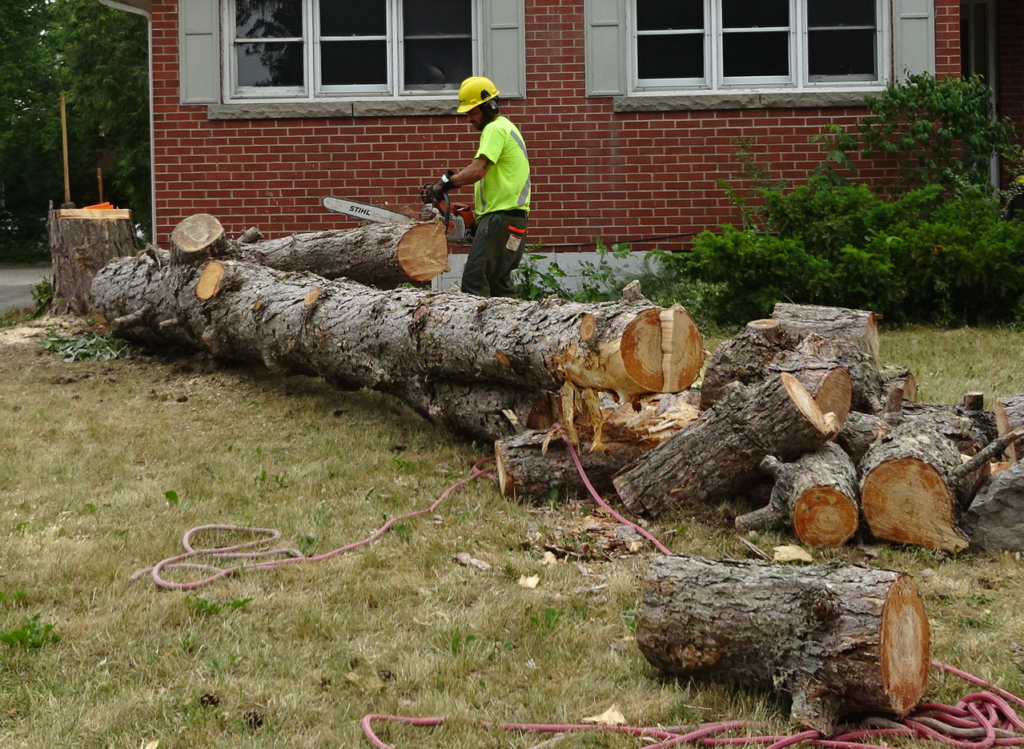 Tree on Guelph Line taken down in the afternoon – residents meet to talk about a private tree bylaw that evening. There were a few people who didn’t want a private tree bylaw. The get together, and that is what it was, was made up of people who wanted trees saved.
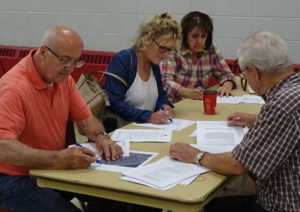 Residents filling out comment sheets. 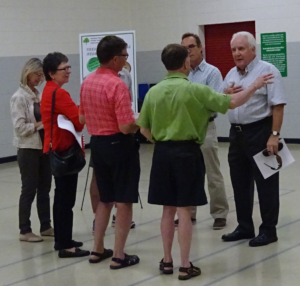 Roseland residents exchanging views on a private tree by law. The meeting was held, some felt, to keep people in the Roseland community happy. The notice of the meeting was apparently limited to that community.
It wasn’t publicly posted by city hall staff.
Councillor Dennison was on hand, the Mayor did not attend. Some felt that a private tree bylaw was his issue and having him in the room would have helped.
To be fair to the Mayor – he could, and often is, out at an event every evening of the week. He either had somewhere else to be or took a deserved evening off.
Copies of private tree bylaws were set out on tables for people to read.

 By Pepper Parr By Pepper Parr
June 23rd, 2106
BURLINGTON, ON
Here it comes
Ontario is launching Canada’s first High-Occupancy Toll (HOT) lanes as part of a pilot project on the QEW—between Trafalgar Road in Oakville and Guelph Line in Burlington—to help manage congestion and add another option for travellers.
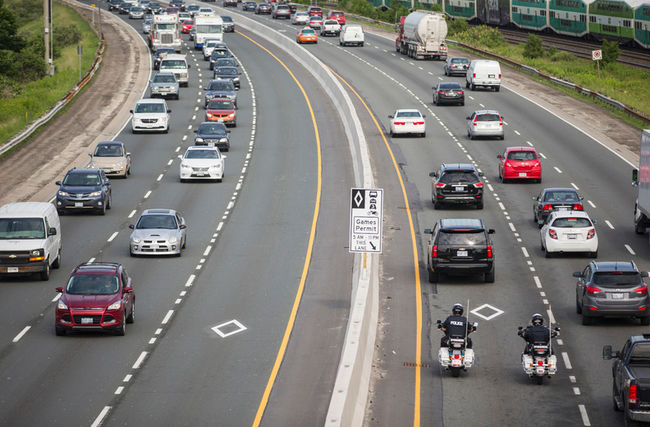 Lanes that were for High Occupancy vehicles (HOV) are about to become HOT – between Trafalgar and Guelph Line – begins middle of September. This new pilot project will start on September 15, 2016. Existing High-Occupancy Vehicle (HOV) lanes on the QEW will be designated as HOT lanes. Carpools of two or more occupants will still be able to use the QEW HOT lanes for free, while single occupant drivers will now have the option to purchase a HOT permit to use them.
HOT permit applications from members of the public will be accepted online from August 1 to August 21 through ServiceOntario. A limited number of applicants will be selected to purchase permits through a draw. The permit will cost $180 for a three-month term.
As part of the pilot, Ontario is issuing a Request for Information seeking innovative technologies that can be used to support tolling, compliance and performance monitoring of HOT lanes for the purposes of testing during the pilot. Possible technologies include telematics, radio frequency identification, video-analytics, GPS, and infrared cameras. The pilot will be used to inform long-term planning for future HOT lane implementation and will also support Ontario’s innovation sector by providing an opportunity to test emerging traffic management and tolling technologies.
 The media release made mention of one objective, which was to keep people and goods moving, connect communities and improve quality of life. Another objective would appear to suck money out of our pockets and into the coffers of the province. $180 for a three-month term – annualized that amounts to $720. Yikes. The media release made mention of one objective, which was to keep people and goods moving, connect communities and improve quality of life. Another objective would appear to suck money out of our pockets and into the coffers of the province. $180 for a three-month term – annualized that amounts to $720. Yikes.
GO trains are looking nicer.

 By Staff By Staff
June 23rd, 2016
BURLINGTON, ON
It will work properly – eventually.
Burlington Transit got all excited about a new computer application that would let you plan a transit trip – it had all kinds of neat whistles and bells – but it didn’t work – so they took it off line. It is now back up- but isn’t working quite they way they want it to work.
The Gazette was to spend time with “marvelous” Mike spice, Director of Transit for the city – to get a full demonstration. That has been put off until it works flawlessly. We will let you know when that bright shiny days arrives.
The Gazette got word from the transit people that site is active again but they are still “testing”.
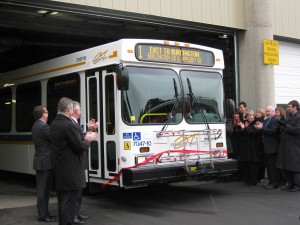 “The problem seems to be with the volume of users accessing the trip planner at the same time. We are not anywhere near our total capacity, but something is causing the system to crash. We think we have worked out most of the issues, but will wait until tomorrow to determine if we have rectified all the bugs.” “The problem seems to be with the volume of users accessing the trip planner at the same time. We are not anywhere near our total capacity, but something is causing the system to crash. We think we have worked out most of the issues, but will wait until tomorrow to determine if we have rectified all the bugs.”
“The only way to determine if we have fixed the issues is to put it live again in order to see how it works in the real environment.”
To be continued.

 By Staff By Staff
June 22nd, 2016
BURLINGTON, ON
The Halton Region Health Department has received test results confirming that a bat found at Honeyvale Road and Swansea Drive in Oakville, on Friday, June 17, had rabies. Residents who may have had physical contact with a bat in this area are advised to immediately contact the Health Department by dialing 311.
 Bat in Oakville found to have rabies “The Health Department is reminding residents to avoid all contact with bats and other wild animals,” said Matt Ruf, Director, Healthy Environments & Communicable Disease for Halton Region. “Anyone who comes in physical contact with a bat or other wild animal should see a physician immediately and contact the Health Department.”
Rabies is a viral disease that causes severe damage to the brain and spinal cord, leading to death. The virus is spread through the saliva of an infected animal, usually entering through a bite. Rabies illness in humans can be prevented after exposure to rabies by the use of rabies vaccine, which is extremely effective, but only if it is administered before symptoms occur.
It is not always possible to identify if a bat has rabies, however rabid bats may move slowly, lose the ability to fly, remain active during daylight hours or be unresponsive to loud noises.
There are a number of things you can do to protect your family and pets:
• Make sure your pet’s rabies vaccinations are up to date.
• Warn your children to stay away from any wild, stray or aggressive animals.
• Do not touch dead or sick animals.
• Do not feed or keep wild animals as pets.
• Keep your pet tied on a leash when off your property.
• Seek medical attention immediately if you come in contact with a potentially rabid animal.
• Any pet that has come in contact with a bat, raccoon or other wild animal should be seen by a veterinarian.
• Report all animal bites or scratches to the Halton Region Health Department.
For more information on rabies, visit halton.ca/rabies or call the Halton Region Health Department by dialing 311.

 By Staff By Staff
June 22nd, 2016
BURLINGTON, ON
It is going to get a little hairy for people who use Lakeshore Road where it cuts away at Maple Avenue.
The city is raising parts of that road, just outside the Joseph Brant Museum as much as a metre and slopping it down until it gets to the end of the water treatment plant – that will close the road from July 4th to Early August 2016 +/-
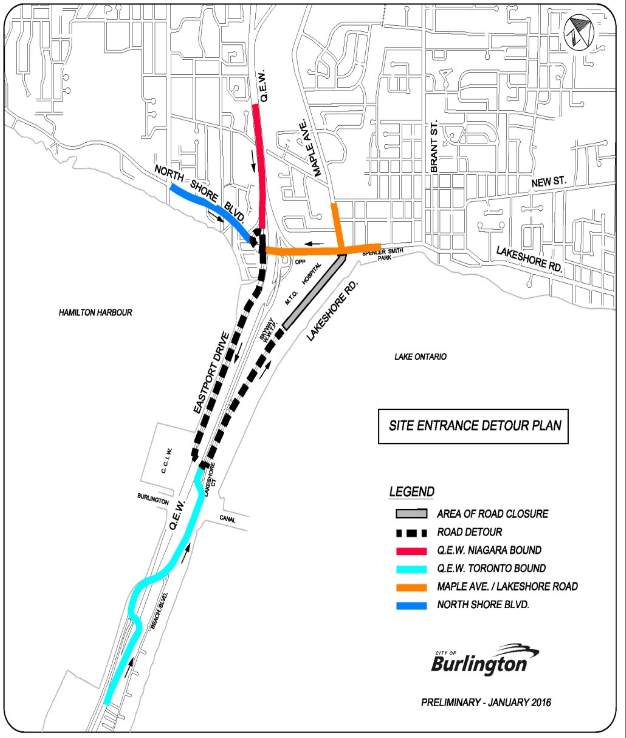 For those that ride their bikes along the old railway line and want to head for Hamilton – bad news – the pedestrian crossing at the lift bridge will be closed frequently: For those that ride their bikes along the old railway line and want to head for Hamilton – bad news – the pedestrian crossing at the lift bridge will be closed frequently:
Burlington Canal Lift Bridge – Daytime Sidewalk Closures
Public Services and Procurement Canada (PSPC) wishes to advise pedestrians and cyclists of restricted access to the Burlington Canal Lift Bridge from July 4 to 29, 2016.
During these dates, the following restrictions will be in place Monday through Friday between 7 a.m. and 5 p.m.:
• from July 4 to 29, the north and south pedestrian underpasses will be closed;
• from July 4 to 15, access to the east (lakeside) part of the Waterfront Trail will be closed;
• from July 18 to 29, access to the west (bayside) part of the Waterfront Trail will be closed; and
• from July 18 to 29, the west (bayside) bridge sidewalk will be closed.
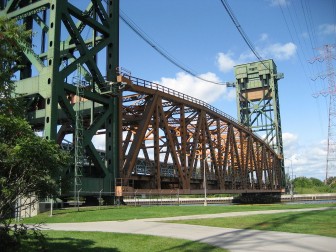 The bridge will remain open to pedestrian and cyclist traffic on weekends and weekdays after 5 p.m. The bridge will remain open to pedestrian and cyclist traffic on weekends and weekdays after 5 p.m.
This schedule may change due to weather conditions or logistical requirements. PSPC will publish notices regarding any changes in schedule.
 Safety is a top priority for PSPC during this project. The closures are required as part of the project to replace the bridge’s controls, drives and cables. The replacement of key components of the bridge’s lift system will extend its serviceable life, meeting the needs of both marine and vehicular traffic in the area. Safety is a top priority for PSPC during this project. The closures are required as part of the project to replace the bridge’s controls, drives and cables. The replacement of key components of the bridge’s lift system will extend its serviceable life, meeting the needs of both marine and vehicular traffic in the area.

 By Pepper Parr By Pepper Parr
June 22, 2016
BURLINGTON, ON
It was a success by any standard.
It was well run, tightly run even when the politicians went too long.
The Premier spoke – she nailed most of the points she wanted to make
There were plenary sessions, breakout sessions and a load of data put up on screens.
The Gazette will report in detail on as much of the daylong event as possible.
Here is a rundown on what took place:
World Economic Trends, by Helmut Pastrick, Chief Economist, Central Credit Union 1
North East Ohio: Inspiring Stories of Regional Collaboration, Bethia Burke, Director of Grantmaking, Evaluation and Emerging Initiatives, Fund for our Economic Future
Toward an Innovation Supercluster: Moderator: Bill Mantel, Assistant Deputy Minister, Ontario Ministry of Research and Innovation with Dr. Patrick Deane, President, McMaster University, Ron McKerlie, President, Mohawk College and Avvey Peters, VP Community Relations, Communitech
Concurrent breakout sessions:
Magnet Cities: A Global View of Local Opportunities; Steve Beatty, Head of Global Infrastructure, Americas and India, KPMG
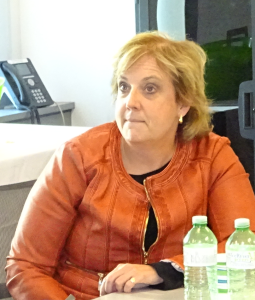 Mary Lou Tanner – Burlington Director of Planing Investing in Mixed Use Transit Hubs; Moderator: Ryan McGreal, Editor, Raise the Hammer, Richard Joy, Executive Director, Urban Land Institute, Suzanne Mammel, Executive Officer, Hamilton – Halton Home Builders’ Association, Mary Lou Tanner, Director, Planning and Building, City of Burlington, Lorna Day, Director, Project Planning and Development, Metrolinx
District Energy: Now’s the Time: Moderator: Martin Lensink, Principal in Charge, CEM Engineering Inc., Dean Comand, President and CEO, Hamilton Utilities Corporation, Robert Marzetti, Director of Business Development , Hamilton Utilities Corporation, Gerry Smallegange, President and CEO, Burlington Hydro and Lynn Robichaud, Senior Sustainability Coordinator, City of Burlington
Planning Culturally Can Unlock Bay Area Growth: Presenter & Moderator: Gail Dexter Lord, Co – President, Lord Cultural Resources; Shelley Falconer, President and CEO, Art Gallery of Hamilton, Robert Steven, President and CEO, Art Gallery of Burlington, Rob Zeidler, Partner, The Dabbert Group
The New Analytics: Harnessing the Predictive Power of Big Data for a Healthier Community. Moderator: Heather Chalmers, Canadian General Manager of GE Healthcare, Rob MacIsaac, President and CEO, Hamilton Health Sciences, Dr. David Higgins, President, St. Joseph’s Healthcare Hamilton, Patrick Horgan, VP Manufacturing, Development and Operations, IBM Canada
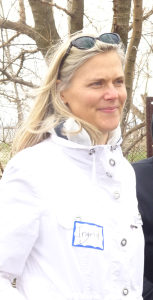 Ingrid Vanderbrug, Landscape Architect, City of Burlington Human Wellbeing Element in the Cootes to Escarpment EcoPark System. Moderator: Terry Cooke, President and CEO, Hamilton Community Foundation Dr. David Galbraith, Head of Science, Royal Botanical Gardens, Maria Fortunato, Executive Director, Hamilton Halton Brant Regional Tourism Association, Wayne Terryberry, Outdoor Recreation Coordinator, McMaster University and Ingrid Vanderbrug, Landscape Architect, City of Burlington
Helping Bay Area Businesses Grow: Moderator: Karen Grant, Director, Angel One Investor Network, Scott Boutilier, Senior Policy Analyst, Ontario Chamber of Commerce, Scott Mackey, VP Customer Success, Adlib Software, Julie Ellis, Chair, Innovation Factory
Bay Area Manufacturing Strengths
Moderator: Dr. Greig Mordue, Chair in Advanced Manufacturing, McMaster University, Tony Valeri, VP Corporate Affairs, ArcelorMittal Dofasco, Irene Hassas, Director, Strategic Planning and Partnerships, Aslan Technologies Inc., Terry McGowan, President & CEO at Thomson Gordon Group
Economic Coordination in the Bay Area, Dr. David Wolfe, Co-Director of the Program on Globalization and Regional Innovation Systems, University of Toronto
Leading Change in a Regional Age: Moderator: Dr. Ishwar Puri, Dean, Faculty of Engineering, McMaster University, Sevaun Palvetzian, CEO, CivicAction, Matt Afinec, Chief Commercial Officer, Hamilton Tiger Cats, Denise Christopherson, CEO, YWCA Hamilton, Ian Hamilton, VP Business Development and Real Estate, Hamilton Port Authority
Investing in our Bayfront: Presenter & Moderator: Sheila Botting, , National Leader, Real Estate, Deloitte. Bill Fitzgerald, VP Operations, Hamilton Port Authority, Chris Phillips, Senior Advisor for Planning and Economic Development, City of Hamilton
The Talent Imperative: Workforce Development in the Bay Area.
Moderator: Judy Travis, Executive Director, Workforce Planning Hamilton, Bronko Jazvac, Director, Health & Safety and World Class Continuous Improvement, ArcelorMittal Dofasco and Member, Mayor’s Blue Ribbon Taskforce on Workforce Development, Louie DiPalma, Ontario Chamber of Commerce, Director of SME Programs Magnet, Kelly Hoey, Executive Director, Halton Industry Education Council (HIEC), Shari St. Peter, Executive Director, Niagara Peninsula Aboriginal Management Board
IBM and its development plans in Canada: Dino Trevisani, President, IBM Canada spoke a little longer than he might have wanted but he did thank Premier Wynne profusely for the province’s cooperation.
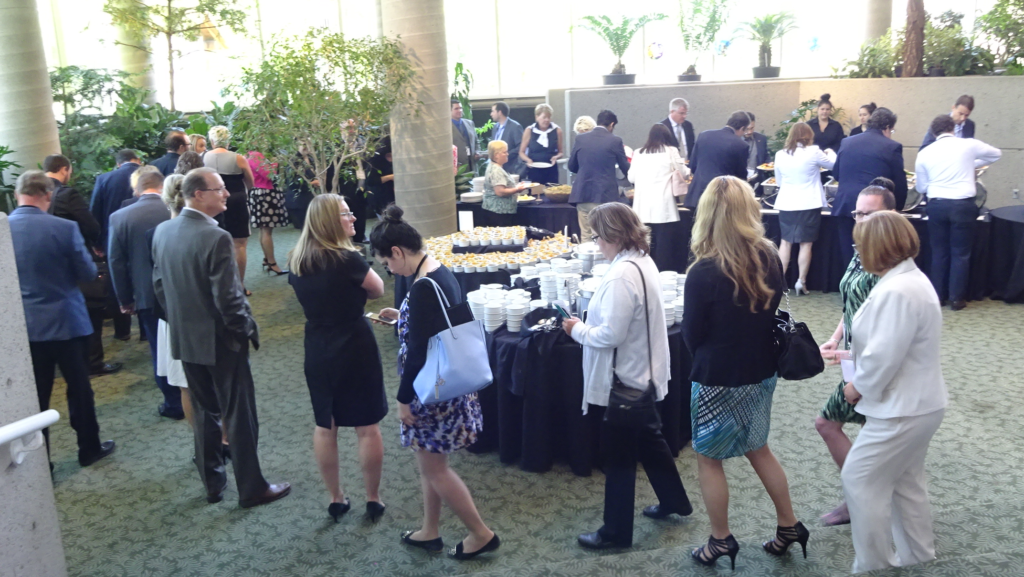 Attendees at the Second Bay Area Summit were well fed. Keanin Loomis and Keith Hooey, from the Hamilton Chamber of Commerce and the Burlington Chamber of Commerce worked together seamlessly. The digs were between the two Mayors – the business guys stuck to their knitting and made it a solid day.
The RGB setting was great – there was plenty of food and snack tables on the go all day.
Will there be a third summit? You can bet on that. The task now is to build on what has been achieved so far and set out some deliverables for the next couple of years.

 By Pepper Parr By Pepper Parr
June 22, 2016
BURLINGTON, ON
BurlingtonGreen advised us this morning that the City is hosting an open house this Thursday, June 23rd between 7:00 and 9:00 pm about a possible private property tree bylaw for the Roseland Community.
 The informal ‘drop in’ open house event will be held at Central Park Arena Auditorium, 519 Drury Lane The Greens are encouraging people to attend and speak up for the rights of the trees. The informal ‘drop in’ open house event will be held at Central Park Arena Auditorium, 519 Drury Lane The Greens are encouraging people to attend and speak up for the rights of the trees.
Burlington Green said they understood the City distributed invitations to the open house to residents of the Roseland Community.
Mayor Rick Goldring has tip-toed around a private tree bylaw – the Greens want him to be more direct. They are advocating for a practical, effective private property tree protection bylaw and supports the implementation of a pilot tree by-law project in Roseland as a key first step to potentially advance a city-wide bylaw, joining 16 other Ontario municipalities that already have private tree by-laws in place.
From producing clean air and adding beauty and property value, to protecting watersheds and mitigating flood damage, trees are an integral part of our community.
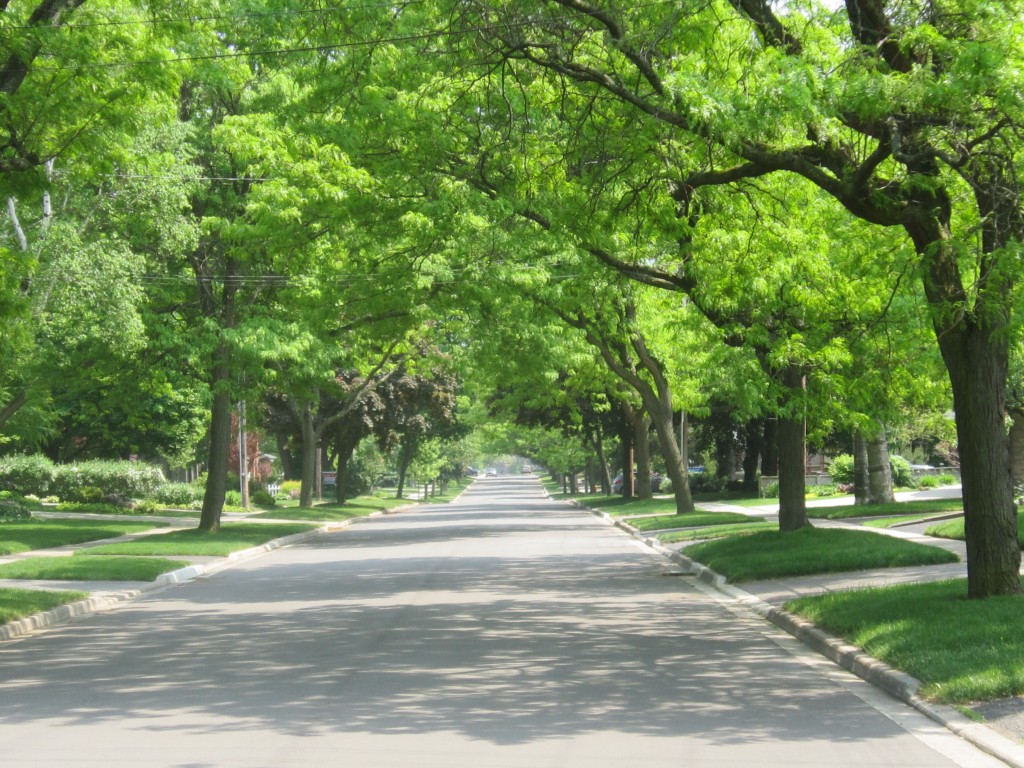 Belvenia on the east side of Burlington. “A tree is a very modest investment in a community and as it grows it is the only asset in the entire city infrastructure that increases in value as it grows”
The Mayor does face a determined group that feel a tree on their property is their property and they can do whatever they wish with that tree. It takes political courage and a will to lead to overcome this kind of thinking.

 By Jim Riley By Jim Riley
June 22, 2016
BURLINGTON, ON
The Art Gallery of Burlington is presenting a visual discussion on the duality of the urban and rural aspects of Burlington. Chief Curator Denis Longchamps, along with the Burlington Fine Arts Association, developed the theme to celebrate the BFAA’s fiftieth anniversary.
There was also a Call for Proposals on this theme, broadening it to a multidisciplinary exhibition. Sixty-six art works were selected, with a very wide range of sizes.
This is a more cohesive exhibition than the All Guilds’ group show in 2015, but it still has challenges to overcome. With this curatorial theme, it has improved the unity of presentation. This exhibit presents an uneven quality of artworks.
This theme gave opportunities for the artists to express their opinions about how the urban and rural co-exist in our city. One of the roles of artists is to raise issues within the culture they inhabit. There are few cities that (philosophically and culturally) declare protection of a rural culture, geopolitically combined with an urban culture the way Burlington has – it was actually the province that imposed that requirement on us.. Many artworks spoke of romantic places, with a varying degree of success.
Longchamps hung the Urban Rural exhibit capably, by tying together themes of content, aesthetics and scale.
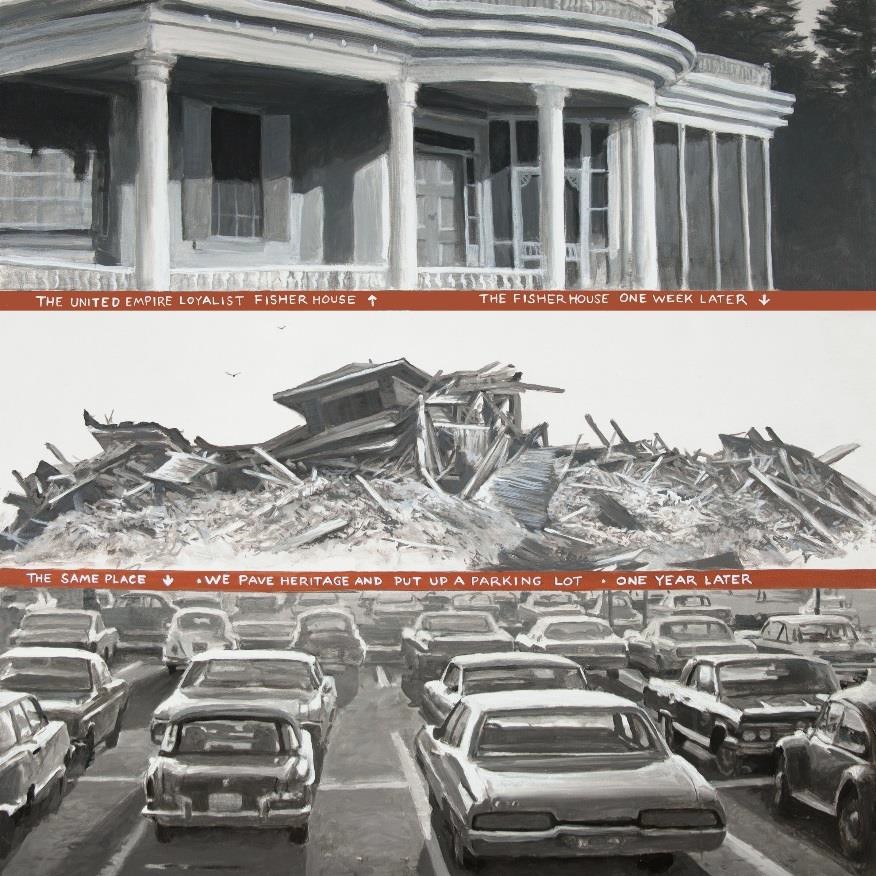 Robert Bateman, Progress, 2015, acrylic Robert Bateman was invited to exhibit. I found it noteworthy that Bateman and Donna Fratesi’s themes dealt with destruction of Burlington’s historic architecture.
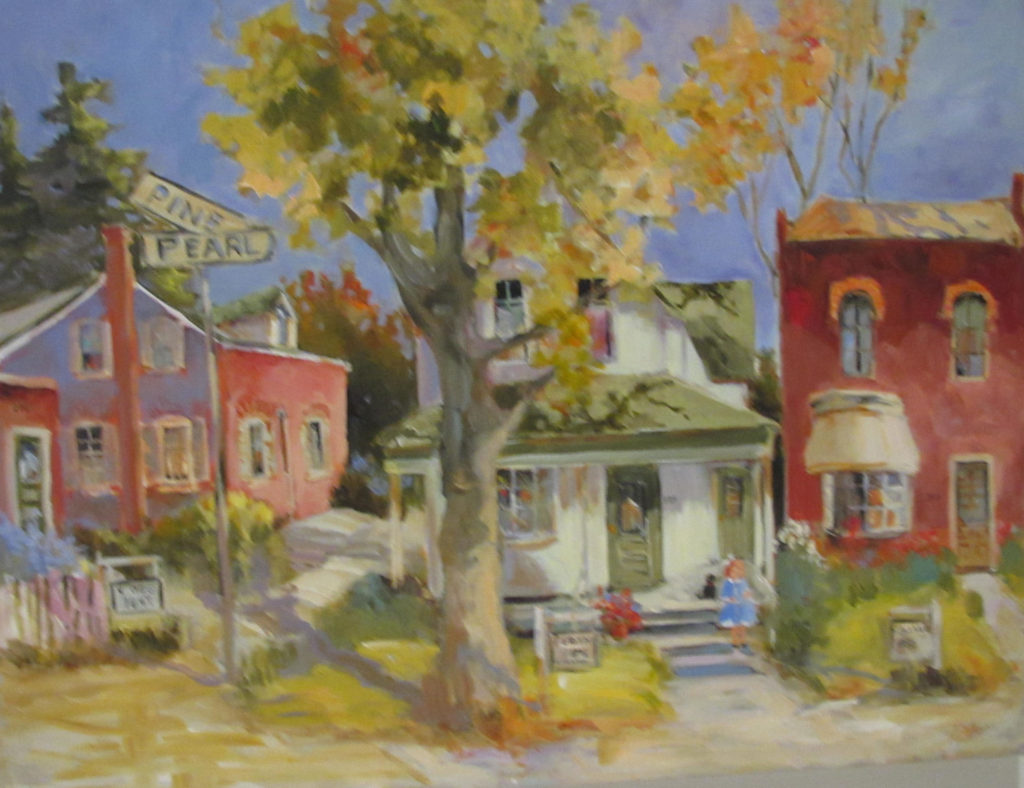 Donna Fratesi’s they paved paradise , 2015 acrylic Fratesi
Both are accomplished technical painters. Bateman was clearer in his thesis than Fratesi’s “They Paved Paradise”. Fratesi seems timid about her message, but evokes a warm memory of the intersection of Pine and Pearl streets. It is a romantic reminiscence of downtown Burlington. Although Bateman relies on text, he creates a clear criticism of Burlington’s treatment of its historic buildings. He focuses on the United Empire Loyalist Fisher house being replaced by a parking lot. Both artists explore their connections to the urban downtown environment, but Bateman’s “Progress” is more directly critical of how we handle it.
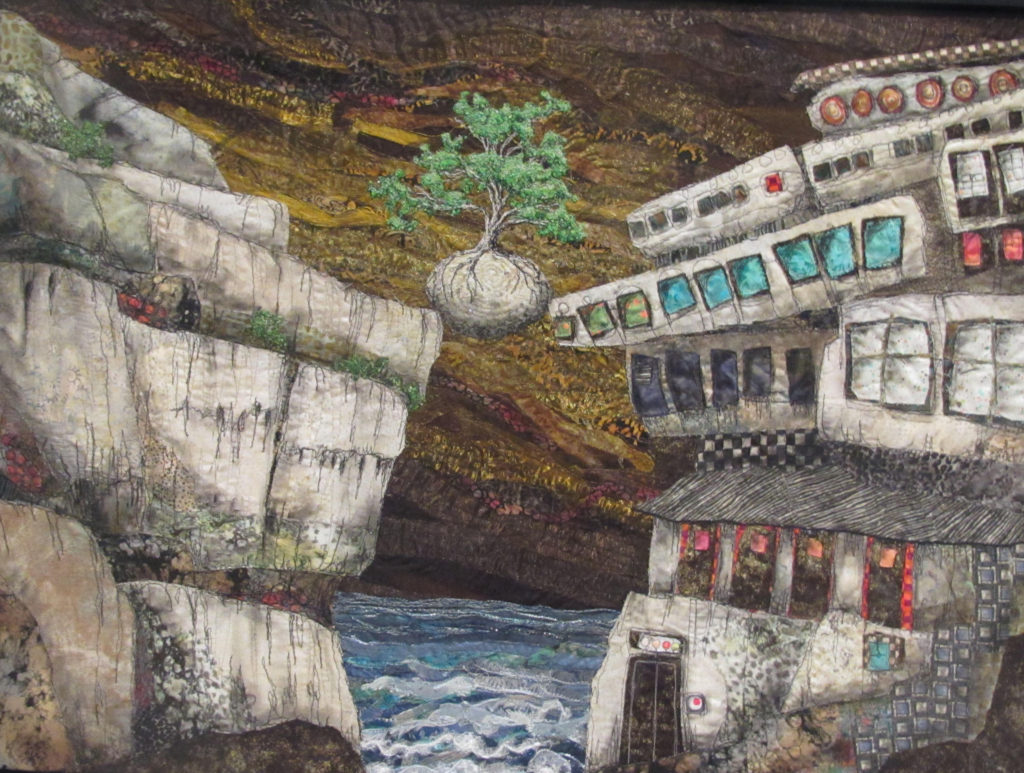 Lorraine Roy, “The Balance”, textile, 2015 Lorraine Roy’s “The Balance” is one of the stronger works in this exhibition. Her textile work not only functions well on a compositional level but demonstrates the “pull and push” between urban and rural ecosystems. The wrapped, uprooted tree balances precariously be-tween the two worlds as it searches for a transplant space. Will it survive? Roy’s imagery is strong with rich tones suggesting a Tim Burton-style nightmare quality. It is intriguingly executed, done with textile rather than paint.
 Helen Griffiths, after a day in (the country), oil, 2015 Similarly, Helen Griffiths’ “After a Day in (the country)” uses her well-developed painterly skills, but also teases the viewer to ponder why she is showing a wild skunk sniffing at a beautiful bundle of roses. The artist statement refers to wild animals invading her neighbourhood. Like Griffiths’ reference to wildlife,
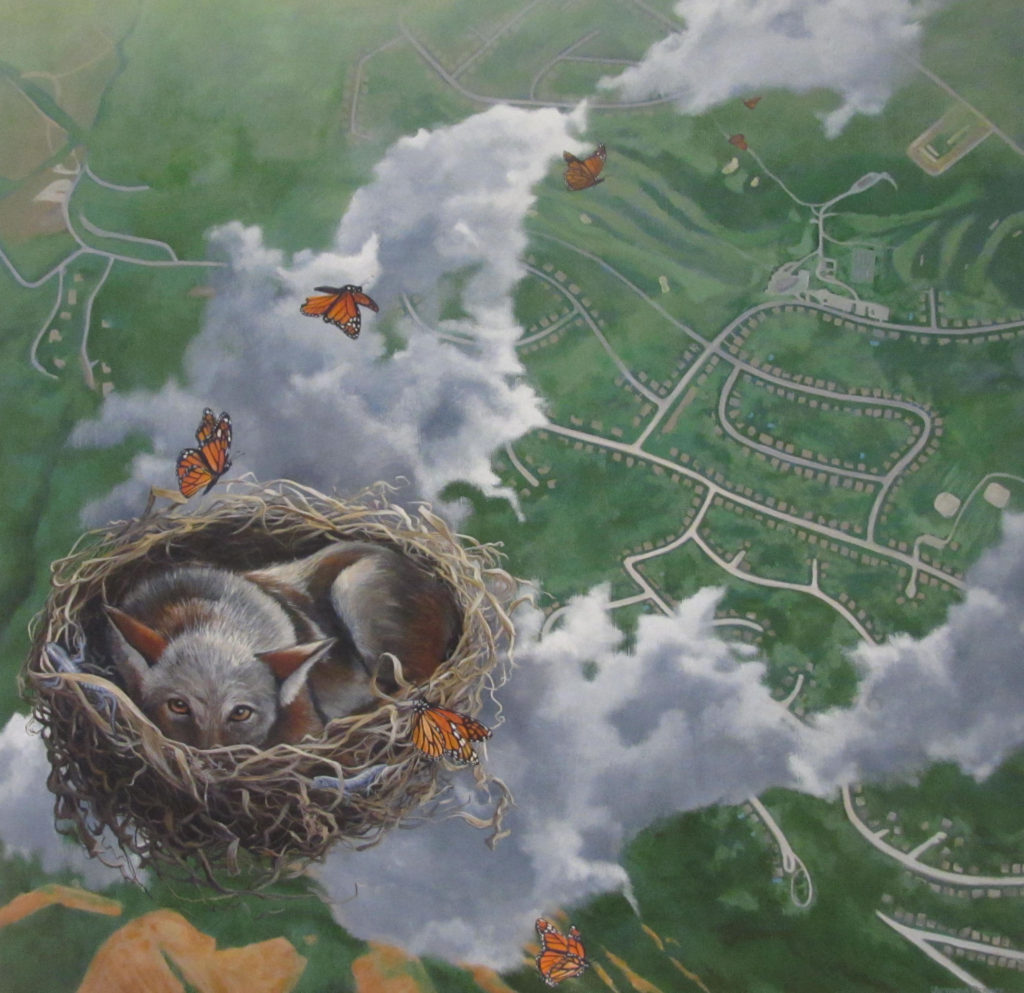 Victoria Pearce, Lost Between acrylic 2016 Victoria Pearce’s “Lost Between” uses images of Monarch butterflies, and the surrealistic imagery of an urban-rural coyote. The coyote is nestled in grasses as it floats over a grid of urban streets. This may be suggesting that a clash between natural and urban worlds is imminent. Certainly, the coyote making itself comfortable in the urban environment is a new reality for Burlington. All three artists successfully combine content and painterly aspects in their art practice.
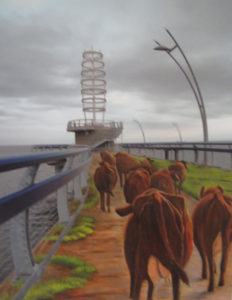 Vanessa Cres Lokos, Moving Forward, 2016, mixed media  Dawn-Hackett-Burns & Michelle Lynn, “Home Grown”, ceramic. Vanessa Cres Lokos, “Moving Forward” and Dawn-Hackett-Burns & Michelle Lynn, “Home Grown” were hung one over the other. Cres Lokos’ expresses her viewpoint on rural and urban issues by placing cows marching along the Burlington pier with a forewarning, overcast sky. Hacket-Burns’ and Lynn’s ceramic artwork explores residential homes overwhelming rural buildings and cattle.
The artwork is placed on a low plinth so that the viewer can hover and oversee the battle.
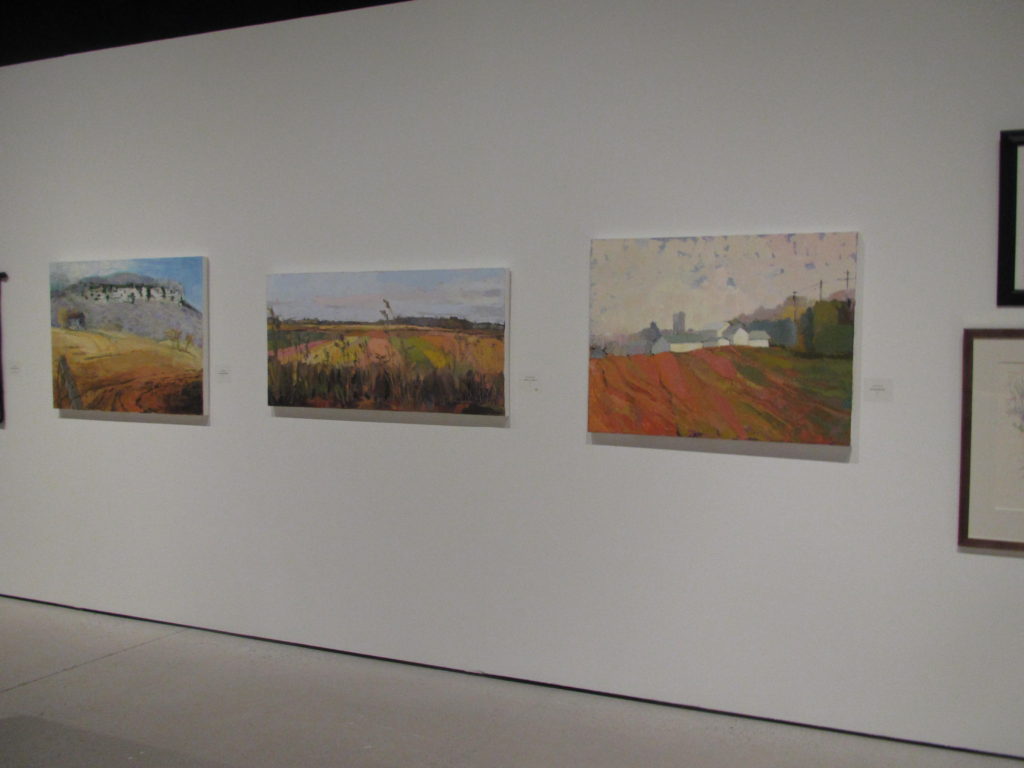 Jan Kendrick, Rossana Dewey, Grace Afonso group image Jan Kendrick’s, Rossana Dewey’s, and Grace Afonso’s paintings were hung side by side. All three artists are skilled painters. They use a similar colour palette and their paintings are emotive and sensually compatible. Their artist statements refer to issues: mining the escarpment, the Greenbelt Plan, the mid-peninsula highway and the vanishing rural landscape. Their images speak of a vast rural environment, but do not deal clearly with the issues expressed in their artist statements.
 Kathy Marlene Bailey, Sanctuary Between, oil, 2016 Kathy Marlene Bailey, “Sanctuary Between” uses curving movement in a watery world of reflections that suggests a more rural, natural aspect of the theme. Her artist statement refers to city planners facilitating a residential invasion of natural sanctuaries. There is beauty and mystery in Bailey’s painting. There is a hint of the escarpment and a house, but the focus is on water. The painting’s message is some-what ambiguous, in comparison to her artist statement.
The Lee-Chin Family Gallery is a large space. Area around the art-works, and the scale of the various artworks, present a challenge. Petit artworks in such a large space are difficult to notice, given the works nearby that are ten feet high. Longchamps creates space and separation for the intimate works.
There may be too many works in the exhibition for a viewer to comprehend, beyond surface aesthetics. I think this is a group exhibition in which less would actually be much more. However, there are many artworks not mentioned here that you should view, to decide on your own.
The exhibition runs until September 5, 2016
Lee-Chin Family Gallery at Art Gallery of Burlington
1333 Lakeshore Rd., Burlington.
AGB Hours
Monday 9:00 am – 6:00 pm
Tuesday – Thursday 9:00 am – 10:00 pm
Friday – Saturday: 9:00 am – 5:00 pm
Sunday: 12 noon – 5:00 pm
Jim Riley is a Burlington, ON, based arts writer, independent curator and a visual and media artist. His recent art practice involves public art and gallery video installations. Riley has a BA from Brock Uni-versity. He has exhibited his art for thirty years in Canada and the United States. Some of Riley’s video art is represented by V tape Distributions, Toronto. Website: www.jimriley.ca

By Pepper Parr
June 21, 2016
BURLINGTON, ON
A colleague mentioned article he had read in Urbanicity, a newspaper (in print) published in Hamilton that had an article by Burlington’s Ward councillor Marianne Meed Ward.
“She nailed it” said the colleague. What you think?
Meed Ward wrote about Intensification and Green space.
 Intensification’s war on greenspace – and what we can do about it. Intensification’s war on greenspace – and what we can do about it.
You’ve probably heard the word “intensification.” Likely in the context of defending a massive new residential over development. Possibly as a fatalistic response to the legitimate desire to protect farmland.
In simple terms, the word means putting more people into less space.
Intensification is supposed to usher in a utopian era of urbanism, saving communities from suburban, car-dependent sprawl while protecting green-space at the same time.
The problem is, intensification has become a war on urban greenspace that threatens to degrade the very communities it creates.
“Intensification” is being used as a bludgeon to justify every new development of any scale in any area, while removing almost every tree, shrub or blade of grass in the way.
This must stop.
For starters, let’s rid ourselves of the word “intensification.” Intensification is a plastic word that means whatever people want it to mean. Instead, we need to talk about the kind of neighbourhoods people want to live in, as our city grows and changes.
It turns out people want to live in traditional neighbourhoods, built before the supremacy of the car: places like downtown Burlington. New communities aim to mimic these historic neighbourhoods. Planners call it “traditional town planning” or the “new urbanism.”
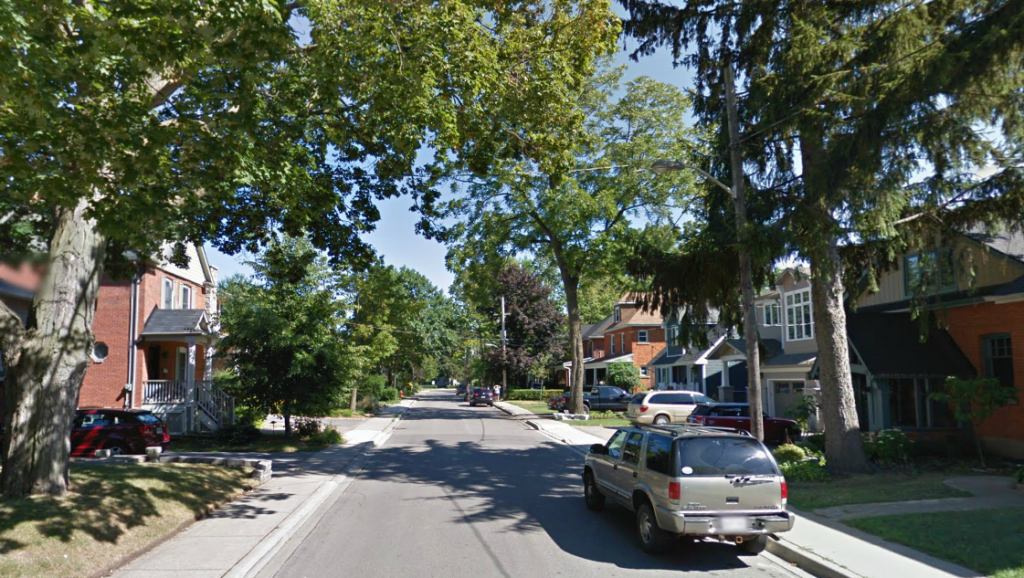 Residents in this community, west of Brant street didn’t like the level o intensification the developer had in mind and they were able to beat back the proposal. The key feature is walkability. But walking has to be pleasant (that’s one reason urban greenspace is important.) And walkability has to mean more than getting a bag of milk, picking up your dry cleaning, or visiting a “parkette” with a bench and a toddler slide.
If you have to get in your car to visit a park large enough to play a game of pick up football, or drive to a big-box store surrounded by parking to get groceries or hardware, or drive to another city to work, or get on a yellow bus to go to school, we haven’t achieved walkability.
All we’ve done is add more traffic.
Trouble is, the intensification we’re getting is almost exclusively residential, with token retail (if at all) that doesn’t come close to satisfying daily shopping needs.
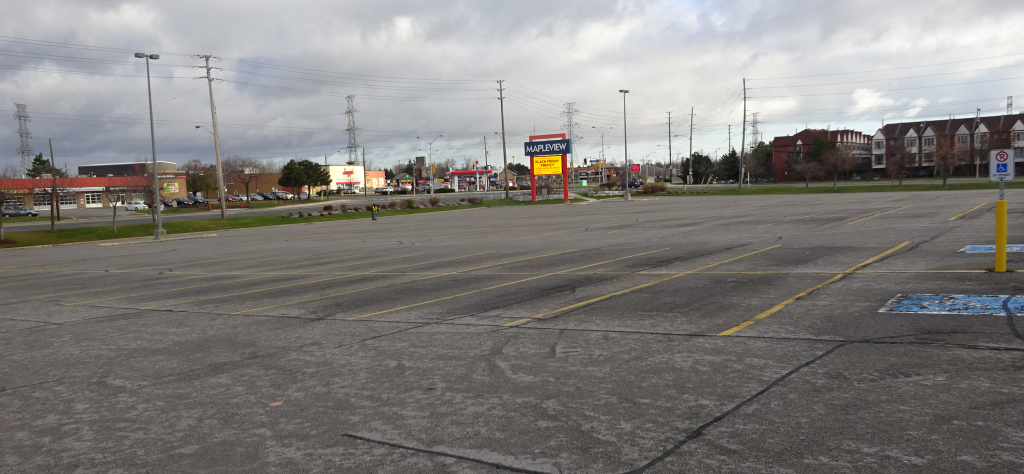 Is this the only solution we have to placing stores in our communities? We won’t build truly walkable communities until we address the commercial side of urban development, and wean ourselves off of the big boxification of shopping, schools and employment. Resi¬dential and commercial uses are still very much separated, with big box retail, office and employment sequestered on barren, clogged and treeless roads surrounded by seas of parking, far from neighbourhoods.
We won’t build walkable communities until people can work and go to school close by. I hear regularly from resi¬dents who’d gladly take a pay cut (and some have) to walk to a job in Burlington. At a recent proposed school clo¬sure meeting, a father spoke movingly about the impor¬tance of walking his kids to school – it was their time to connect. Other parents said they’d gladly keep their small, old school within walking distance, than go to a big, brand new school far away.
Finally, we won’t build truly walkable communities until we make walking pleasant. That means beautifying our city, and adding urban greenspace. Trouble is, new developments sprawl all over their sites taking up greenspace; the taller the building, the more sprawl, with development virtually covering lot line to lot line, especially in downtown areas where land is at a premium. We end up with the equivalent of a vertical suburb, with no greens¬pace. “Amenity areas” are counted as balconies and party rooms.
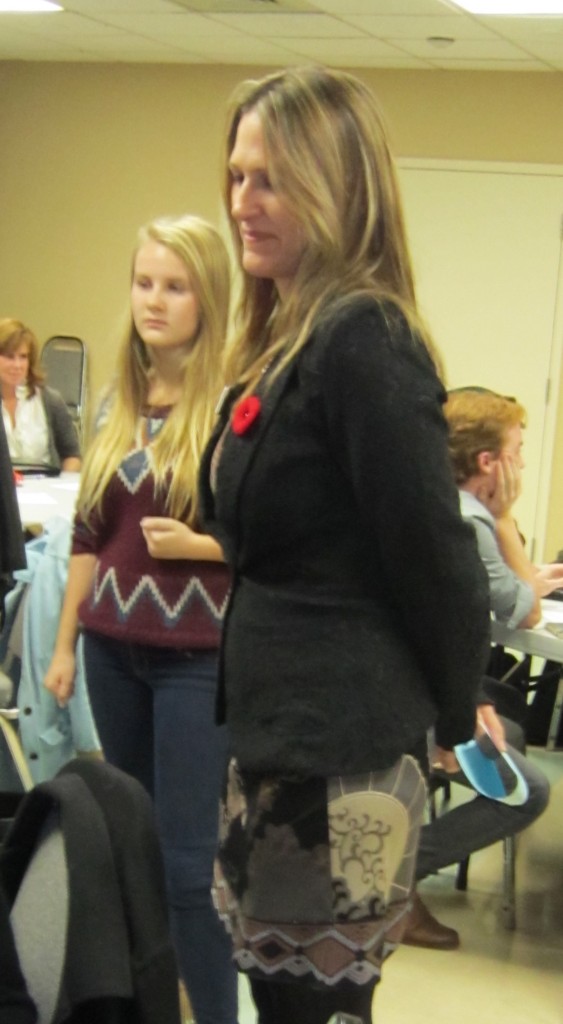 Ward 2 Councillor Marianne Meed Ward with her daughter Miranda. The Councillor is expected to challenge the current mayor Rick Goldring for the chain of office in the 2018 municipal election, Even in our newer “smart growth” neighbourhoods that were supposed to be the antidote to suburban sprawl, there’s almost no greenspace around homes, virtually no room to plant a backyard tree or the space to grow the root system for a large boulevard tree. New townhouse developments have even more asphalt and less greenspace. To compensate for the lack of land to absorb stormwater runoff, we build underground cisterns.
We must do better. Here are just a few steps we can take to fight intensification’s war on urban greenspace:
• Value urban greenspace as much as rural. The province has protected rural Burlington via Greenbelt legislation; our job is to protect and add to urban greenspace. We shouldn’t trade off one for the other. City folk need greenspace every bit as much as rural folk.
• Aim higher than green roofs, low flow toilets, geothermal heating and the like for sustainable urban development. As important as these are, they don’t replace the need for actual trees and urban greenspace.
• Revise zoning to require more setbacks, trees, permeable land, low impact development, and onsite passive greenspace in urban redevelopments.
• Take parkland dedication on redevelopments as land, rather than fees as we do now. That would instantly add urban greenspace.
By shifting the conversation from “intensification” to community, we create neighbourhoods where people want to live. I hear regularly from residents who’d gladly take a pay cut (and some have) to walk to a job in Burlington

 By Pepper Parr By Pepper Parr
June 21st , 2016
BURLINGTON, ON
Well, this could be awkward.
Burlington now has two Cabinet Ministers – a week ago we didn’t have one.
Eleanor McMahon (Burlington) was made Minister of Tourism, Culture and Sport and Indira Naidoo-Harris, (Halton) Associate Minister of Finance, whose task it was to shepherd the planned Ontario Pension Plan into being.
 Yesterday the Ontario Minister of Finance announced that the province would abandon their plans for Ontario Retirement Pension Plan – what then does the Ms Naidoo-Harris have in the way of a job? Yesterday the Ontario Minister of Finance announced that the province would abandon their plans for Ontario Retirement Pension Plan – what then does the Ms Naidoo-Harris have in the way of a job?
There is considerable controversy around whether or not pension plans actually need radical changes – the Conservatives certainly don’t think so.
Milton MP Lisa Raitt was very vocal last week with her views on pension changes.
Charles Sousa, Ontario Minister of Finance said in a statement: “There is an emerging retirement income challenge in Canada, and in Ontario. Workplace pensions are becoming less common and less adequate. Two-thirds of Ontario workers don’t have access to a workplace pension plan, and only one in four younger workers — aged 25 to 34 — participate in a workplace pension plan. Too many Ontarians are starting to approach retirement without the pension and savings they need.
“Our government ran on and won a majority mandate on a promise to enhance retirement income security for the people of Ontario. Today has seen a national agreement in principle to enhance the CPP that meets our commitment to hard-working Ontarians.
“Ontario has always favoured a national solution to strengthening retirement security. Since 2013, we have been calling on the federal government to enhance CPP because a national solution provides many benefits to Ontarians, including portability and cost effectiveness, while providing coverage to more people.
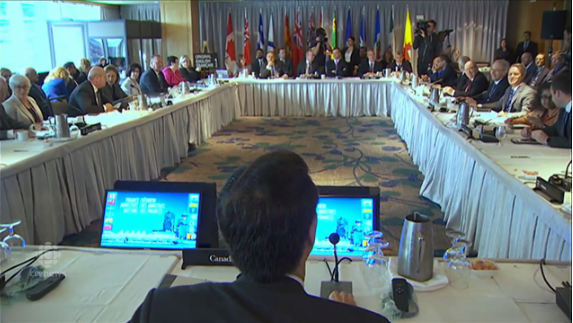 Federal and provincial politicians meet in Vancouver – they decided to create a more beneficial pension plan. “In the absence of a willing or collaborative federal partner at that time, Ontario began establishing the Ontario Retirement Pension Plan (ORPP).
“Ontario’s extensive consultations in developing the ORPP determined that to meet Ontarians’ retirement needs, CPP enhancement would have to be timely and provide a level of adequacy and coverage that reflects the design of the ORPP.
The federal government and enough of the provinces appear to have reached an agreement in principle to expand the Canada Pension Plan today.
So what does Indira Naidoo-Harris do now? Hopefully she didn’t print up to many business cards.
Naidoo-Harris is the member for NAME which includes large parts of rural Burlington.

 By Pepper Parr By Pepper Parr
June 21, 2106
BURLINGTON, ON
They are meeting and they are talking but that band of artists, musicians and actors that created ACCOB (Arts and Culture Collective of Burlington) and began to call themselves the “collective” are ready to make an announcement about what they feel is a significant step forward. Just when is not certain.
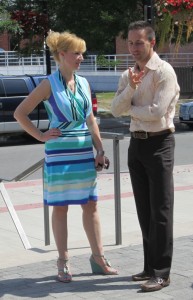 Angela Papariza currently handles the cultural file at city hall – she has few resources to work with. One of her strongest allies is Trevor Copp who lit the flame that is keeping the water boiling within the arts community. As yet however, the arts community doesn’t yet have the ear of the civic administration and without a serious commitment by city council to fund the arts – little is going to happen.
The relationship between the arts crowd and the city manager is not good – one artist has said the city manage lies to them.
Inflammatory for sure – but that is where things appear to be with the artists.
Back in 2013 Trevor Copp, a dancer you want to see perform at least once in your lifetime, raised the profile of the arts community when he delegated to city council and got all the usual platitudes.
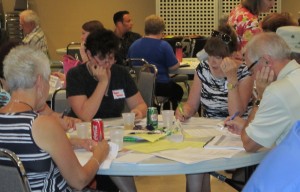 Teresa Seaton, organizer of the Art in Action Tour, thinks through a response at one of the Cultural Action Plan sessions. She is one of 250 people organized as an Arts and Culture Collective in Burlington. While the elected officials did little – the arts community began to organize themselves and are pressing city hall staff – to little effect so far.
There is in this city, a significant number of people who want to see a more vibrant culture – something that is above and beyond the Sound of Music and the Teen Tour Band. They have their place, an important one – but there is more than that to culture.
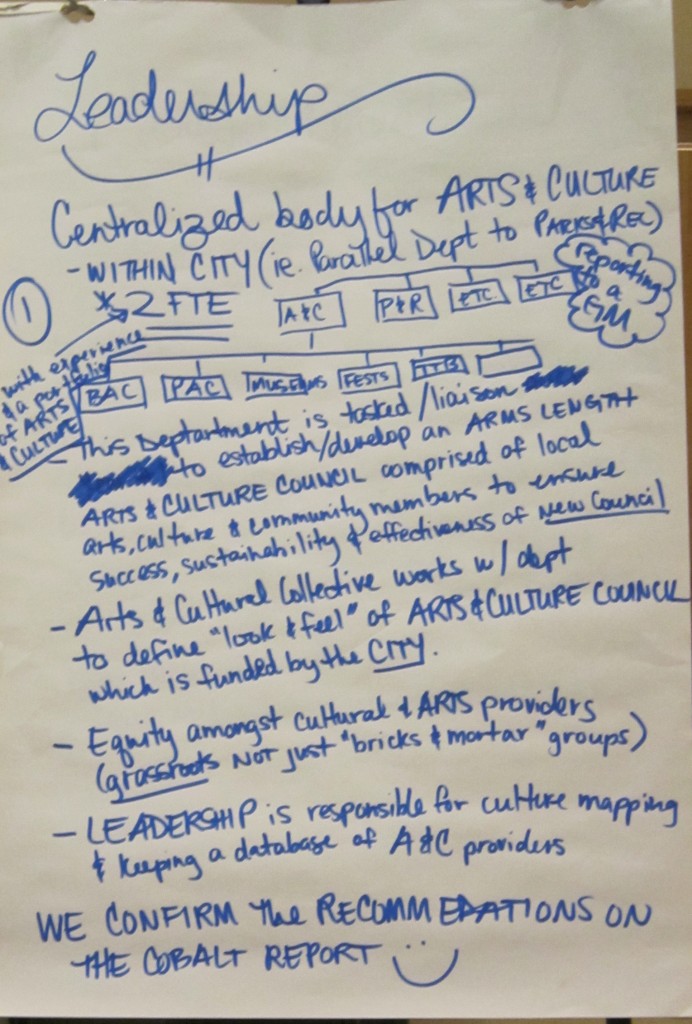 The Collective has done their homework – they know what they want – now to actually get it – that’s their challenge. Expect to see the arts community beginning to network and make connections with some of the people who wrote the large cheques that paid for the construction of the Performing Arts Centre and work with them for more quality and substance that can be put before the public.
It might get a little messy – but the world of arts and culture has seldom been a smooth one.
It is the performance that counts – not all the petty politicking that we are seeing now.

 By Staff By Staff
June 20th, 2106
BURLINGTON, ON
Burlington Cabinet Minister Eleanor McMahon wants you to understand that she believes fervently that young people play a vital role in building our community.
 “To better understand issues impacting youth across the province and right here in our city, I organized a group of engaging Burlington high school youth to gain their perspectives”, said McMahon in a media release “To better understand issues impacting youth across the province and right here in our city, I organized a group of engaging Burlington high school youth to gain their perspectives”, said McMahon in a media release
“One of the issues the group is passionate about is making Syrian refugees feel at home when they arrive in Canada. As part of their effort to welcome these families, they’ve created a video that tells their story about coming to Burlington.”
A year in the making, this video explores the idea of what “home” means and highlights the emotional challenges faced when leaving behind the home you know and having to build a new one in an unfamiliar community.
The video will be screened at Burlington central Library June 28th, 7:00 to 8:30 pm

 By Staff By Staff
June 20, 2016
BURLINGTON, ON
Liberal MP Karina Gould released details today on a federal government program that will empower seniors to share their knowledge, skills and experience with others and support communities by increasing their capacity to address local issues.
Organizations are being invited to apply for funding for projects that address one or more of the program’s five objectives:
1. promoting volunteerism among seniors and other generations;
2. engaging seniors in the community through the mentoring of others;
3. expanding awareness of elder abuse, including financial abuse;
4. supporting the social participation and inclusion of seniors; and
5. providing capital assistance for new and existing community projects and/or programs for seniors.
 Karina Gould, Liberal MP, listening to a senior. Eligible applicants include: not-for-profit organizations; coalitions, networks and ad hoc committees; municipal governments; research organizations and institutes; educational institutions, public health and social service institutions; aboriginal organizations; and for-profit enterprises.
Projects that received funding during the 2015-2016 proposal call year included the Burlington Baptist Church’s Circle of Friends and Community Development Halton’s Senior Connector Program.
More information on how to apply is available at Canada.ca/Seniors or contact MP Gould’s office directly at 905-639-5757.

 By Staff By Staff
June 20, 2016
BURLINGTON, ON
Movies Under the Stars is back – first show is July 7th at Nelson Park.
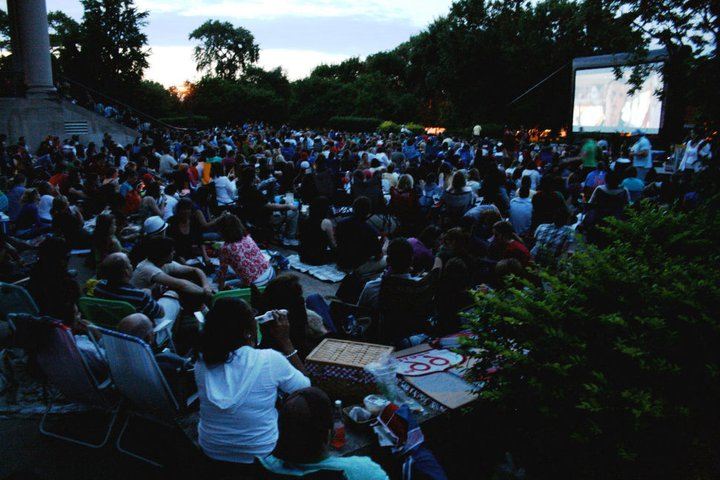 A family event – Movies Under the Stars The screens move around the city offering free family movie screenings in local parks every Thursday until Aug. 18.
This annual tradition has become a very popular summer activity for families, it is a safe, free, fun evening in front of the big screen.”
The films featured in the summer movie series were selected by residents who voted in online polls earlier this spring. The winning movies and locations are as follows:
Minions July 7 Nelson Park
Kung Fu Panda 3 July 14 Aldershot Park
Singin’ in the Rain July 21 Central Park Bandshell
Inside Out July 28 Emerson Park
WALL-E Aug. 4 Kilbride Park
Goosebumps Aug. 11 Ireland Park
The Good Dinosaur Aug. 18 Spencer Smith Park
Each movie will begin at 9 p.m. and will be shown on a 25 by 14 foot (7.62 by 4.27 metre) outdoor viewing screen. Starting at 7:30 p.m. each week, Healthy Kids Community Challenge will be leading games and activities for the whole family aimed at improving children’s health and nutrition.
Moviegoers are encouraged to bring their own lawn chairs and blankets. Washrooms and limited parking are available at each park. Consider walking or riding a bike to the event.

 By Staff By Staff
June 18th, 2016
BURLINGTON, ON
LaSalle Wading Pool is closed for the remainder of the day due to an unforseen maintenance issue.
The Splash Pad will remain open until 7pm, free admission.
The Wading Pool will reopen Sunday June 18, 2016 at 11am.

|
|
 By Staff
By Staff

















 Early, early the 5K Canada Day run takes place.
Early, early the 5K Canada Day run takes place.


 Traffic:
Traffic:















 “The problem seems to be with the volume of users accessing the trip planner at the same time. We are not anywhere near our total capacity, but something is causing the system to crash. We think we have worked out most of the issues, but will wait until tomorrow to determine if we have rectified all the bugs.”
“The problem seems to be with the volume of users accessing the trip planner at the same time. We are not anywhere near our total capacity, but something is causing the system to crash. We think we have worked out most of the issues, but will wait until tomorrow to determine if we have rectified all the bugs.”

 For those that ride their bikes along the old railway line and want to head for Hamilton – bad news – the pedestrian crossing at the lift bridge will be closed frequently:
For those that ride their bikes along the old railway line and want to head for Hamilton – bad news – the pedestrian crossing at the lift bridge will be closed frequently: The bridge will remain open to pedestrian and cyclist traffic on weekends and weekdays after 5 p.m.
The bridge will remain open to pedestrian and cyclist traffic on weekends and weekdays after 5 p.m.



 The informal ‘drop in’ open house event will be held at Central Park Arena Auditorium, 519 Drury Lane The Greens are encouraging people to attend and speak up for the rights of the trees.
The informal ‘drop in’ open house event will be held at Central Park Arena Auditorium, 519 Drury Lane The Greens are encouraging people to attend and speak up for the rights of the trees.













 Yesterday the Ontario Minister of Finance announced that the province would abandon their plans for Ontario Retirement Pension Plan – what then does the Ms Naidoo-Harris have in the way of a job?
Yesterday the Ontario Minister of Finance announced that the province would abandon their plans for Ontario Retirement Pension Plan – what then does the Ms Naidoo-Harris have in the way of a job?




 “To better understand issues impacting youth across the province and right here in our city, I organized a group of engaging Burlington high school youth to gain their perspectives”, said McMahon in a media release
“To better understand issues impacting youth across the province and right here in our city, I organized a group of engaging Burlington high school youth to gain their perspectives”, said McMahon in a media release

